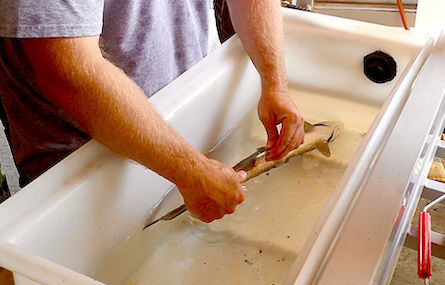forum
library
tutorial
contact

'This is Worse' than 2015: Northwest Weather
Heats Rivers, Puts Idaho Sockeye in Danger
by Rocky Barker
Big Country News, July 4, 2021
|
the film forum library tutorial contact |

|
'This is Worse' than 2015: Northwest Weather
by Rocky Barker
|
"There is a way to avoid it but we're not doing those things"
 BOISE -- Salmon in the Columbia, Snake and even Salmon rivers are swimming into lethally hot waters that are at even higher temperatures than when nearly all of the Columbia and Snake sockeye died in 2015.
BOISE -- Salmon in the Columbia, Snake and even Salmon rivers are swimming into lethally hot waters that are at even higher temperatures than when nearly all of the Columbia and Snake sockeye died in 2015.
"This is worse," said Lisa Crozier, a research biologist for NOAA Fisheries in Seattle.
That's because the water temperatures in 2015 of 68 degrees and hotter came a little later in the summer. The unprecedented extreme heat in the Pacific Northwest, combined with low river flows, drove the river temperatures into the 70s earlier this week, threatening not only sockeye, but other migrating salmon and steelhead in the rivers.
Temperatures in the Snake River reached 74 degrees, and even the upper Salmon River warmed to 75, said Eric Johnson, a research biologist for the Idaho Department of Fish and Game. Salmon begin to die when water temperatures reach 68.
TRUCK AND HAUL SOCKEYE
Fish and Game biologists are preparing to collect sockeye from below Lower Granite Dam -- the final dam on the Snake River near Lewiston -- and truck them to the Eagle Hatchery, the headquarters of the successful captive rearing program, which prevented endangered sockeye from going extinct in the 1990s and 2000s.
The agency was able to save 35 Snake River sockeye by trucking in 2015. Another 56 sockeye made the perilous trip to Redfish Lake on their own. Biologists had counted 4,000 sockeye that year at the Columbia River's Bonneville Dam. Hundreds of thousands of sockeye headed for the upper Columbia also died in 2015.
Forecasters predict that excessive heat will continue throughout the Pacific Northwest through July 12 this year, forcing salmon to suffer through an extraordinarily long, hot migration period.
"Currently, we are planning to continue trap and haul operations through July 23," said John Powell, a research biologist for Idaho Fish and Game. "This end date may need extended depending on the extent of migratory delays through the Columbia and Snake rivers downstream of Lower Granite Dam."
So far this year about a third of the expected 1,200 to 1,300 Snake River sockeye expected at Bonneville Dam on the lower Columbia have already passed. They have to cross seven more dams before they return to the Sawtooth Valley -- nearly 900 miles away and 6,500 feet above sea level.
Most years, more than 50 percent survive their early life in Redfish Lake, migrate to the Pacific as juveniles and spend two years in the ocean, and then return to spawn.
HOT WATER AND DAMS
Crozier said collecting and trucking sockeye and other salmon will have to become routine as temperatures continue to rise.
Crozier is one of the co-authors of a report released earlier this year that said Columbia and Snake salmon and steelhead could go extinct by the end of the century because of rapid human-caused climate change. Salmon face threats from warming temperatures throughout their life cycle in both the Pacific habitat and inland areas.
"There is a way to avoid it but we're not doing those things," Crozier said.
In Washington, a state board reported Monday that it will exercise the Washington State Department of Ecology's authority to act against federal dam operators to reduce water pollution. The Washington Pollution Control Hearings Board said it will require the U.S. Army Corps to operate dams and reservoirs to comply with the state's stricter new standards, The Seattle Times reported.
The water temperature is just another issue adding to the controversy over the effort to remove the four dams on the lower Snake River in Washington state to try to prevent the extinction of salmon and steelhead. Some models show that a free-flowing lower Snake River would be within temperature limits.
Overall, the ongoing heat wave across the Northwest has increased awareness about the effects of climate change, Crozier said, but it's tougher for the salmon.
"They don't have air conditioners," she said.
Related Pages:
Count the Fish, 1977-2014, Salmon Recovery Effortsby GAO
learn more on topics covered in the film
see the video
read the script
learn the songs
discussion forum
